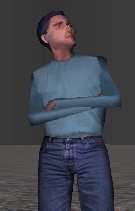|
Although VR requires special tools, it is its unique functionality that distinguishes it from other technologies. Particularly, VR is a system that not only fools human senses but also motivates human imagination. Powerful computer worlds could alter patterns of development that we have considered to be an invariant by allowing us to interact with them in ways we can not interact with our "real" world. This interaction could not only be altered in terms of the timing of the event, but in terms of the types of functions available for constructing our knowledge. Other important contributing factors are immersion and high interactivity, which makes it possible for students to experience what they are learning about in an entirely new way. For example, giving student's control of usually inaccessible environmental variables (such as, e.g., gravity) will help them to acquire correct understanding about basic physics principles. The "potential naturalness of interactions" with objects in a VR is much easier and therefore, more effective than in any other types of computer-based environments.
 To keep students away from the task boredom, the courseware should be content-attractive, informative, interactive, dynamic and adaptive. VR simulations could allow not only an existing reality recreation, e.g., the opportunity to "perform" experiments that might be otherwise too inaccessible, time consuming or too dangerous for students to do in the laboratory, but also create a non-existing "artificial reality" expanding beyond real world situations as well as to "magnify" reality down to atomic scale. Depending on details, the learning material is presented with variable degrees of "realism" by disposing of or exaggerating certain features, as well as to "visualize" invisible and conceptually-enhanced features. Then it will be possible within such an environment to move smoothly and gradually from a percept-like simulation to the conceptually clean simulation of the phenomena. To keep students away from the task boredom, the courseware should be content-attractive, informative, interactive, dynamic and adaptive. VR simulations could allow not only an existing reality recreation, e.g., the opportunity to "perform" experiments that might be otherwise too inaccessible, time consuming or too dangerous for students to do in the laboratory, but also create a non-existing "artificial reality" expanding beyond real world situations as well as to "magnify" reality down to atomic scale. Depending on details, the learning material is presented with variable degrees of "realism" by disposing of or exaggerating certain features, as well as to "visualize" invisible and conceptually-enhanced features. Then it will be possible within such an environment to move smoothly and gradually from a percept-like simulation to the conceptually clean simulation of the phenomena.
In this sense, VR provides a means for students to design and experience the world from different perspectives, with desired outcomes being to understand it better and open the human mind to new conceptual ideas that would otherwise be inaccessible through real world experience. Indeed, VR simulations have been proven to be very successful as an entertainment tool (video-games) or a tool to train individuals on certain procedures (surgical simulators for surgeons and driving simulators for pilots). Therefore, the powerful VR interface is ideal in applications, which have a need for flexibility, realism and group participation at reduced simulation cost. The above qualities make VR an obvious choice as technology tool in science education.
|


